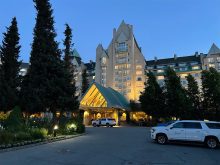While a fog of gloom seems to hang over much of rural Canada, there are some bright spots – places that are growing or planning to grow, places thinking creatively about renewing themselves.
One of them is Hafford, Sask., about an hour’s drive northwest of Saskatoon. In many ways it is a typical prairie community.
Peter Kingsmill is the mayor. His varied career includes stints as a river boat operator, community developer and newspaper publisher. He’s an enthusiastic person who likes to jump in and go for it. He knows that people choose where they live. He and the town council want to give folks reasons to choose Hafford.
Read Also

Downturn in grain farm economics threatens to be long term
We might look back at this fall as the turning point in grain farm economics — the point where making money became really difficult.
Kingsmill recognizes that planning is essential.
“Some people see plan as a four-letter word,” he says.
He thinks instead of an eight-letter word: planning. That’s what guides communities, especially in the excitement of good times, or the challenges of down times.
Kingsmill sees an opportunity for Hafford to hold onto things that are important to people, and then do more. He sees that Hafford could be a base for people working in the oil industry or in cities such as Saskatoon, Prince Albert and North Battleford. He’s aware that people moving to Saskatchewan are finding cities too expensive and are looking for more affordable places. As well, the already-popular Redberry Lake area has recently been designated a biosphere reserve by the United Nations Educational, Scientific and Cultural Organization, which has drawn additional interest.
Prairie Wild Consulting is working with the town to develop the Hafford and Community Sustainability Plan because of the belief that economic sustainability and environmental sustainability are both essential. Prairie Wild’s partners, Lenore Swystun and Kelley Moore, have done community planning in Canada, Africa and the Caribbean.
Kingsmill says another plus is that Swystun grew up on a farm just a few kilometres from Hafford. Kingsmill says people have added confidence in Swystun because she knows the area and people know her and her family.
Moore and Swystun are involving the entire community in the planning process. About 20 people attended the most recent meeting in late July. Participants reviewed a vision statement on which they had worked. They discussed present and future land use, such as commercial use, recreation and where the housing should go, including possible multi-unit buildings.
Residents spoke with enthusiasm and conviction, not only about their own town but about initiatives in other communities that might be possible in Hafford – places like Paris and Victoria. The discussion groups had many similar ideas, and some surprising differences. All those suggestions received thoughtful consideration by the entire group.
And as Hafford people look elsewhere, other municipalities in the area are watching what’s happening in Hafford.
Work on the Hafford and Community Sustainability Plan will continue through the summer and fall. Kingsmill expects the town council will receive the report by spring and then start setting priorities on what can be done. But right now, he’s “very happy with the way things are proceeding.”
Rob Brown is a former agricultural writer and broadcaster now doing studies in ethics. He can be reached at moral.economy@sasktel.net.

















